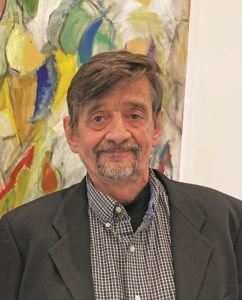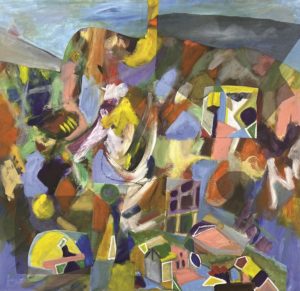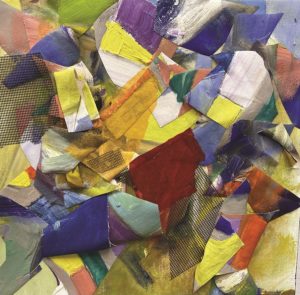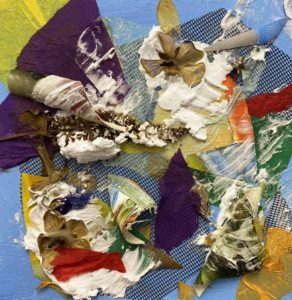“I think it grew out of my frustration as a painter,” Daniel Wagner says, looking around at the many canvases lying about his cluttered Provincetown Commons studio. “What do I do with all this stuff? Are they more valuable in the trash than they are on the wall? Is this painting more valuable when it becomes part of a whole?”

Wagner, who shows at Sarah Jessica Fine Arts in Provincetown, is hoping to find the answer to those questions in an exhibit of recent work that he’s set up at the Commons through Nov. 14, with a reception on Friday the 5th. These new paintings are covered with cut-up pieces of earlier paintings, along with mesh and other materials. The resulting artworks are layered collages and assemblages: some appear deceptively flat unless you inspect them closely, while others are clearly three-dimensional.
Large and small, the paintings are “abstract in spirit,” Wagner says. “But there are always figures. I had a stack of 50 or 60 12-by-12s with figures on them that I used.”

The inspiration for the series was a model Wagner created as part of a competition for an outdoor sculpture installation at the Commons. The model was of a jumble of black steel drums filled with paintings, many of them spilling out. It wasn’t chosen in the end, but this little sculpture of an art trash pile gave him an idea: “Can these paintings I discarded as trash become art?” He thought it over, he says, and “I took a knife to my paintings and made collages out of them.”
Wagner came around to being an artist later in life. He grew up in a small town in rural northeastern Wisconsin. “It was a very provincial place,” he says. “We didn’t have art. I didn’t know that people could actually have careers in art. I didn’t know what an art museum was until I went to college.”

He studied architecture at the University of Minnesota. “I knew from drafting classes in high school that I wanted to be an architect,” Wagner says. “I ended up being a technical architect more than anything. I would make the pretty pictures work, coordinating with structural and mechanical engineers. Pure corporate architecture — high rises and super high rises. An 88-story building in Shanghai. I was there for a year and a half for its construction.”
He worked at major firms in Chicago, including Skidmore, Owings & Merrill, for more than 25 years. “I love Chicago,” Wagner says. “I went back a few weeks ago. It was great to be there again — the energy of the city, great architecture. Hearing the L go by. I went downtown to see the Art Institute. It’s humbling going to that museum. You think of your paintings and wonder, what am I doing?”

It was his health that made him think of becoming a painter. “I had a liver transplant,” he says, and, after recovering, “it was hard to keep up with fellow workers. In corporate architecture, you work 80 to 90 hours a week.”
Being largely self-taught as an artist, he says he was attracted to “strange things,” which, he learned, were abstractions. He read up on Hans Hofmann’s push-and-pull color theory. “Not knowing much, I went to an old bookstore and came upon it,” he says.
He started painting as much as he could. “I did the art fair circuit to sell my work,” Wagner says. “In the Midwest, it’s very popular. Every weekend, I loaded up my little truck and pitched a tent. Anybody or everybody walks into your tent — you get people who understand art and people who don’t.” One day, he remembers, “This little grandmother came up to me and said, ‘You’re blessed.’ I didn’t have any sales that day, but that was all I needed.”

He came to Provincetown for a one-month vacation in 2012. “I fell in love with it,” he says. “The first five years, I came back in the winter, because it was affordable. I kept myself busy with figure drawing, at PAAM,” referring, of course, to the Provincetown Art Association and Museum. In 2016, he moved here for good.
Which brings him to the Commons, and his new show. “It’s hard, as an abstractionist, to come with a style or body of work,” Wagner says. “You’re exploring and doing new things all the time. It’s not like being a realist — they just work on their skills as a realist. I never thought I’d be playing around with collage. Or found art. Trash turned into art. But putting another painting on top of it helps to simplify a painting. I felt I had too much going on.”
Push, Pull, and Paste
The event: “Suspended Action,” a show of new works by Daniel Wagner
The time: Opening reception Friday, Nov. 5, 5 to 7 p.m.; on view through Nov. 14
The place: Provincetown Commons, 46 Bradford St.
The cost: Free



